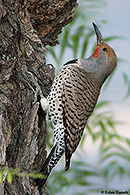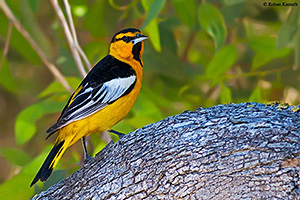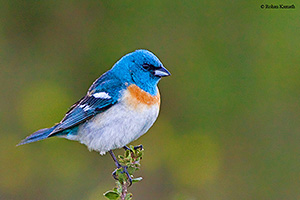Great Plains Hybrids |
|||||||||||||||||||||||||||||||||||||||||||||||||||||||||||||
|---|---|---|---|---|---|---|---|---|---|---|---|---|---|---|---|---|---|---|---|---|---|---|---|---|---|---|---|---|---|---|---|---|---|---|---|---|---|---|---|---|---|---|---|---|---|---|---|---|---|---|---|---|---|---|---|---|---|---|---|---|---|


 Photographs of a Northern Flicker, Bullock's Oriole and Lazuli Bunting by Rohan Kamath |
|
||||||||||||||||||||||||||||||||||||||||||||||||||||||||||||
| Although this "spread of
agriculture and planting of trees" scenario appears likely
for at least some of these species (e.g., the jays),
extensive field studies and better understanding of the
dynamics of hybridization over the past 20 years have led to
challenges of this view. The stability of hybrid zones for
several species pairs has led some ornithologists to
conclude that contact between them predates the arrival of
European agriculture. In fact, Audubon recorded a mixed pair
of flickers and their brood near the present Montana-North
Dakota border, an area where hybrid flickers still
predominate. Across the range of locales where they overlap, only seven of the 14 species pairs have been adequately studied. Based on these studies, members of four of the hybridizing pairs previously treated as separate species have been combined into single species (Northern Flicker, Tufted Titmouse, Rufous-sided Towhee, Northern Oriole). The orioles and buntings are particularly well studied and provide some interesting examples of hybrid zone dynamics. It appears that the Baltimore Oriole form is extending its range westward and replacing the Bullock's Oriole form both in the Canadian prairies and along the Platte River in Nebraska and Colorado. Along the Platte River, the geographic center of the hybrid zone between the two orioles has shifted 200 km westward over the past two decades. In contrast, the Bullock's appears to be extending eastward across southern Kansas and replacing the Baltimore at a similar pace, with the hybrid zone center shifting by 100 km eastward over the past decade. In spite of these shifts, the width of the hybrid zone has not increased. For the most part, there is little indication of assortative mating (the preferential mating of each oriole with individuals of the same form) or of selection against the hybrids. Although an estimated one-third of Indigo and Lazuli Buntings hybridize in areas of contact where they are equally abundant, hybrids appear to have reduced viability, putting them at a selective disadvantage relative to pure Indigos or Lazulis. For this reason, the two buntings are, unlike the orioles, considered sufficiently distinct to be classified as separate species. The range of the Indigo has expanded westward by 200 km over a 15-year period in northern Nebraska and in western Kansas. In areas of regular contact, song switching between the species and interspecific territoriality both occur. The extent of hybridization between members of the other seven pairs is poorly known for most areas of contact. The amateur as well as professional ornithologist can help clarify the relationships between these closely related species by carefully noting the composition of breeding pairs in these areas and their reproductive success. SEE: Hybridization; Species and Speciation; NaturalSelection; Superspecies; Sibling Species; Taxonomy and Nomenclature. Copyright ® 1988 by Paul R. Ehrlich, David S. Dobkin, and Darryl Wheye. |
|||||||||||||||||||||||||||||||||||||||||||||||||||||||||||||